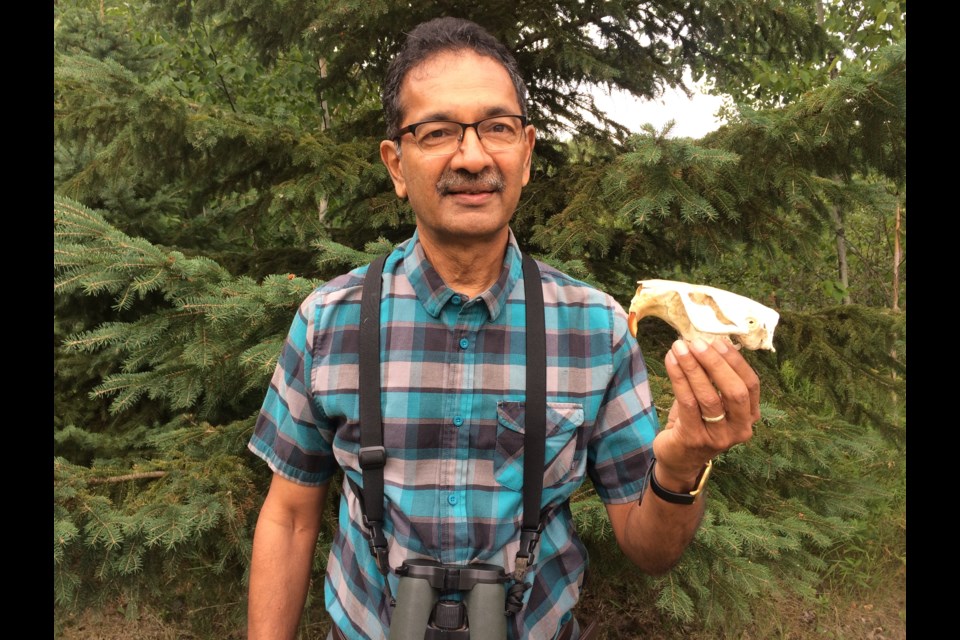Fred Pinto holds a beaver skull in the palm of his hand, explaining the impact beavers have on ecosystems, landscapes before leading this month’s interpretive hike through Laurier Woods.
“We started in May with birds, and then plants, insects and now beavers. We offer free guided hikes on the first Saturday of every month and will continue into November. We get different people who are knowledgeable about specific aspects of nature to lead the hikes,” said Pinto who is the President of Friends of Laurier Woods.
“There is so much around here for people to learn about. It is meant for everybody in the family. It is free and it is activity-based, so it is not just lectures, it is actually, touching, looking, listening and participating.”
Tom Brouse brought his son and two granddaughters on the walk to learn more about these iconic mammals.
“I have a real interest in the history of this area and nature, so I wanted to bring my granddaughters out to be in the bush and understand the heritage of North Bay,” said Brouse.
“Before we got here, we were talking about the history of the fur traders and the beaver was the main reason this area got developed so we wanted to learn more about beavers. And we wanted to see the birds and nature in general. We have a real appreciation for it.”
One of his granddaughters’ Trinity Hotchkiss enjoys the peaceful environment.
“I’m interested in just being outside seeing nature. It is calming for me. And we’re lucky to be surrounded by all this nature.
Marilyn Polkinghorne has gone on several hikes through Laurier Woods.
“I’m here because I wanted to learn more about nature and how beavers affect the environment, and we just love the woods. We love hiking, so it is just something to do right here in the city.”
Often associated with flooding, Pinto explained the benefits humans derive from beavers.
“They create the wetlands in here. These wetlands in Laurier Woods store about 217 thousand cubic metres of water, equivalent to about 85 Olympic size swimming pools. When we have really fast thawing of snow in the spring or huge amounts of rain falling, these wetlands store the water and release it slowly,” explained Pinto.
“The other thing it does is clean water. So, the bacteria and the plants that live in here they’ll break down different materials and make the water cleaner as it moves off into Lake Nipissing.”
Pinto explained that beaver ponds last about 25 years before the beavers eat themselves out of home and move elsewhere.
“We call them keystone species because they create habitat for a whole bunch of other things that live in nature.”
An Adjunct Professor at Nipissing University, Pinto is instrumental in getting students to study beavers at Laurier Woods.
“I teach at Nipissing University and three years ago I had some students do some research here to look at different factors that might affect beavers and look at what is happening to the ponds we have here at Laurier Woods,” said Pinto.
“They found two things. One, the threat level is increasing. There is a large amount of human activity and dog activity around the main pond, but less in the back ponds,” said Pinto.
“And they also found the food source is getting less in these areas. Actually, the beaver dam will break at some point, the beavers will move away, and it will turn into a beaver meadow.”
Guide Riley Cormier focused on insects during his walk, specifically flower flies and bees, native pollinators, and what humans can do to protect them.
“There are over 4,000 species of just native bees in Canada and the United States. So, there is a huge diversity and they come in all ranges of colours,” said Cormier.
“The bees around here, typically about 70 per cent of them, will actually nest in the ground or in the bark. The other 30 per cent will nest in tree cavities and holes. We have the bee hotel, so they like to use things like that too.”
Cormier explained the workings of the hotel.
“The bee hotel is a raised structure and it has twigs with pre-drilled holes of different sizes and the bees will use holes that they fit into. Native bees and even flower flies are important for pollination. Laurier Woods is pretty healthy because there is a wide variety of flowers. So, when you come through here you will see different varieties of flowers in bloom and because you have the wetland, tall trees and older trees. There is plenty of places for them to nest and raise their young.”
Assistant guide Julie Falsetti explained that planting native flowers in gardens is a good way to help sustain native bees.
“If you can give them a food source, they will come. For instance, if you plant just one black-eyed Susan plant, you will get native bees visiting it.”
Also, this month, the 6th Annual Louise de Kiriline Lawrence Nature Festival is scheduled for Saturday, August 17.
Hosted by the Nipissing Naturalist Club and Friends of Laurier Woods the free event offers outdoor activities for the entire family, including a variety of exhibits.
This year a local falconer will have a static display.
Parking is off Brule Street.
A schedule of coming events is posted on Facebook as well as the Friends of Laurier Woods website.



